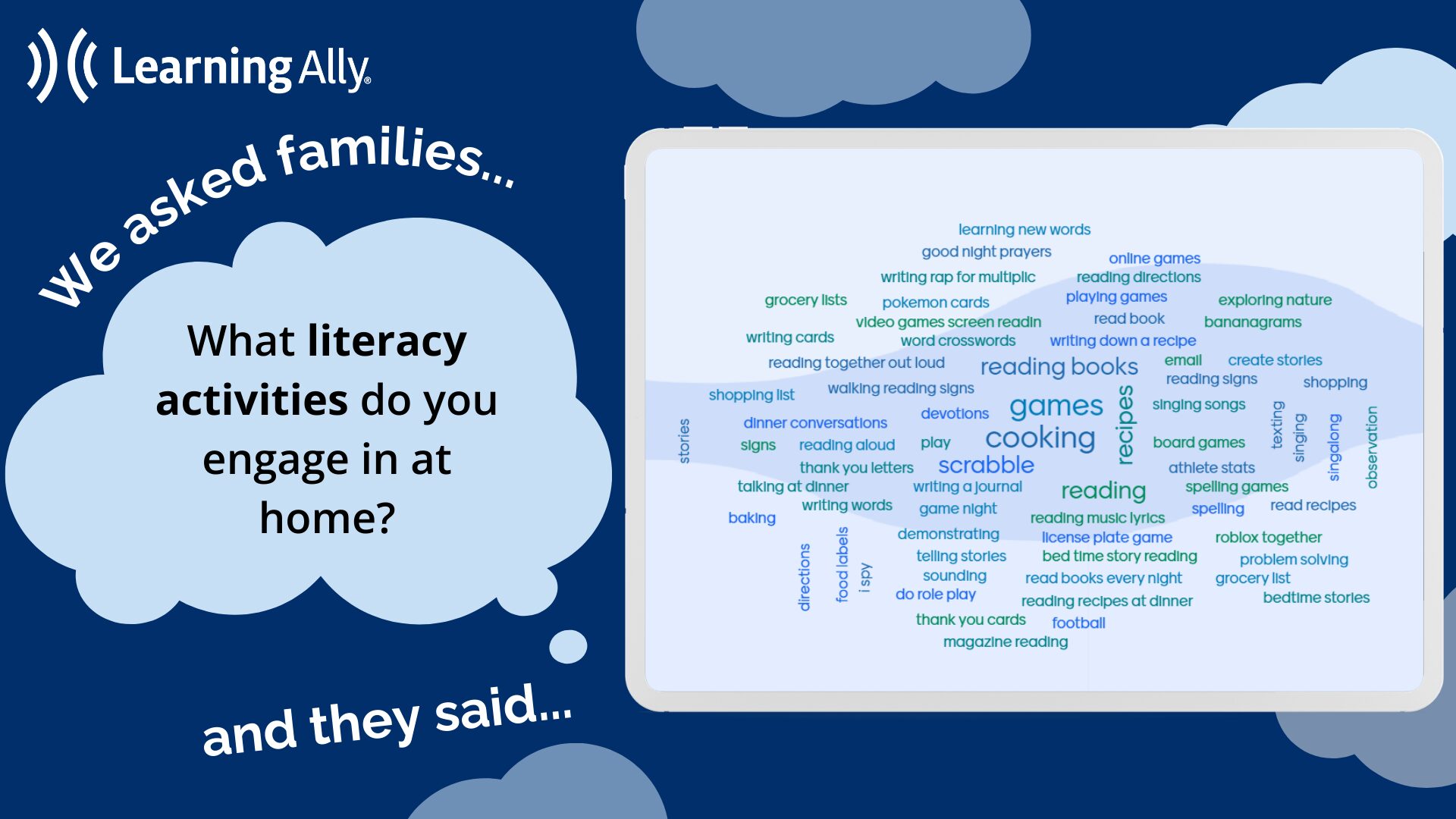Literacy development isn’t confined to the classroom; it’s a collaborative effort that extends to the home, with parents and caregivers playing a crucial role.
Engaging students at home and on the go in daily literacy activities can create a more enriching learning environment and significantly impact your child’s reading and writing skills. That’s why Learning Ally has put together some practical tips to help you support your child’s reading journey best.
Before we dive in, let’s get clear on why literacy is so important.
Understanding the Importance of Literacy
Literacy is the foundation of a child’s education. It opens doors to knowledge, critical thinking, and opportunities. Strong literacy skills lead to better academic performance, improved communication skills, and increased confidence. By nurturing these skills early, you set your child up for lifelong success.
As an ed-tech nonprofit organization, we know parents play an important role in a child’s learning and development. That’s why as a part of our solutions, Learning Ally works closely with community partners, government officials, schools, and educators to ensure parents are equipped with the right knowledge and resources to be a piece of their child’s education puzzle.
Supporting literacy at home doesn’t have to be a daunting task. With practical tips, parents and caregivers can make learning outside the classroom fun at any age.
Daily Activities to Promote Literacy
- Read Aloud Daily: Make reading a daily habit. Choose a variety of books that interest your child and read aloud together. This not only improves their listening skills but also introduces them to new vocabulary and concepts.
- Create a Reading-Friendly Environment: Have a dedicated reading space at home filled with books, magazines, and other reading materials. Make it cozy and inviting to encourage your child to spend time there.
- Engage in Conversations: Talk with your child about their day, their interests, and the books they’re reading. Ask open-ended questions to stimulate critical thinking and enhance their verbal skills.
- Incorporate Literacy into Daily Activities: Turn everyday tasks into learning opportunities. For instance, ask your child to help write a grocery list, read recipes while cooking, or follow instructions for a DIY project.
- Use Technology to Help: Leverage educational apps and e-books, like Learning Ally’s Audiobook Solution and Excite Reading, to make reading interactive and fun.
Through frequent exposure to activities like this, students can build stronger vocabulary, background knowledge, writing, and speaking skills. This knowledge may also extend to achieving a greater sense of independence, confidence, and ability to express thoughts and feelings.
Tips from Parents and Caregivers:
In a recent Family Literacy Night Event hosted in partnership with a California-based school district, Learning Ally asked parents and caregivers to share what activities they engage in outside the classroom to support literacy with their child.
Here’s what they said:

Families shared that they engage in a variety of activities to promote literacy, such as:
- Reading Together: Many families make it a habit to read together, whether it’s bedtime stories or shared reading of books and articles. Some families even shared they enjoy using podcasts, reading the transcripts as they listen.
- Library Visits: Regular trips to the library allow families to explore new books and participate in community reading programs.
- Educational Games: Board games, puzzles, and educational apps that focus on vocabulary and comprehension are popular.
- Storytelling: Creating and telling stories are common practices that help children develop their narrative skills.
- Writing Activities: Families often engage in writing letters, keeping journals, and creating stories together.
We also asked our volunteers and staff to get involved and share real-life examples of how they’ve connected family time with literacy-building activities.
Sheree, a longtime volunteer with Learning Ally, shared:
“Our literacy activity began by chance. My daughter and I lived 1,100 miles apart from my sister and her son. Both my daughter and her son had trouble focusing on printed material, but both loved to create and tell stories. My daughter wrote a clever, short piece called The Story of Kimberlee and I happened to send it to my sister because it got a very positive response from my daughter’s teacher. My sister read the story to my nephew. Within a few weeks, we received a new episode, which my daughter could not wait to read. The back and forth went on for over a year, with the story getting more complex as they tried to up each other’s game. The strategy was not planned, I did not study results for either child, but both had fun reading and writing while they built a relationship with each other. From my perspective, engaging in this process left us all excited to read and write.”
Paula, Director of Volunteer and Corporate Partnerships here at Learning Ally, shared that her daughter was practicing words in Spanish when she was just one and a half years old, which she learned by reciting words back to her father after he spoke them to her. See her in action here.
Opportunities to read and learn together are all around us. Engaging with your child in literacy activities outside of the classroom can be beneficial at any stage of their education, whether in elementary, middle, or high school.
We want to know, what are some ways you’re building literacy at home with your family?
Tell us in the comments below!
Author:
Maria Lelie,
Program Manager, Community Services